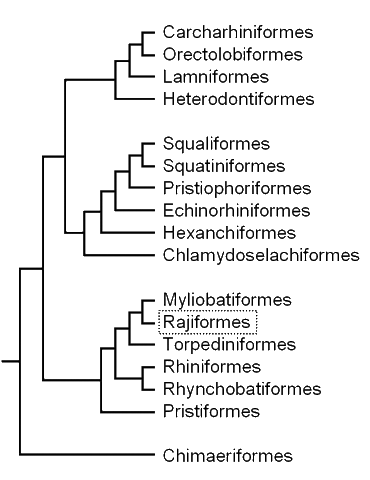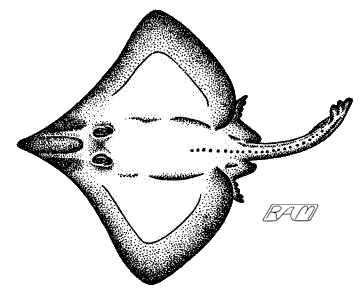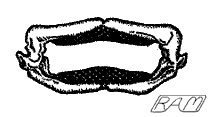Batoids: Order Rajiformes:
Skates — 257 to 275 species

- snout pointed
- pectoral disc usually rhomboid
- tail slender, set off from pectoral disc
- caudal fin moderately well developed, reduced or absent; weak electrogenic organs at base of tail stalk (derived from caudal peduncle muscles)
- 0 to 2 dorsal fins
- most with enlarged, thorn-like denticles ('bucklers') on skin, often with a row along midline of back
- oviparous
- almost exclusively marine; a few species live in shallow waters close to shore, but most live in deep water, on soft bottoms along continental margins, down to 8 840 feet (3 000 metres) or more
- 26 genera in a single family (Rajidae), divided into 2 subfamilies

Longnose Skate (Dipturus rhina)
Rajoids lead unobtrusive, secretive lives, mostly hidden away in deep waters beyond human commerce and concern. Some of the shallower dwelling forms are heavily fished for their thick, tasty wings (which are sometimes punched into disk-shaped plugs of flesh and sold to the unsuspecting consumer as "scallops"). One species, the formerly 'Common' Skate (Dipturus batis) was fished so intensely in the Irish Sea, that it became extinct there by about 1970. On the other side of the Atlantic, three shallow water species, the Clearnosed (Raja [Leucoraja] eglanteria), Little (Leucoraja erinacea), and Winter (Leucoraja ocellata) Skates are biological celebrities, being frequently used in physiology experiments (including studies on osmoregulation, reproduction, and cancer) due to their small size and easy maintenance.
The Big Skate (Dipturus binoculata), one of the most common skates in the eastern North Pacific, is often encountered by divers and adapts well to captivity. As a result, its basic life history is better known than that of most skates. This species munches largely on crustaceans and bottom associated fishes. Female Big Skates mature at a disc-width of just over 4 feet (1.3 metres) and an age of about 12 years, males at about 3.5 feet (1 metre) and an age of 10 to 11 years. The largest Big Skate on record was about 8 feet (2.4 metres) across. The egg cases of this species are impressive, too: up to a foot (30 centimetres) long and containing as many as seven eggs. (Talk about putting all your eggs in one basket!)
Skate eggs are encapsulated in a tough, rectangular case made of keratinized collagen rich in sulphur, which grants the cases antibacterial properties. Skate eggs are often preyed upon by carnivorous snails, elephant seals, and — in one documented case — another skate.
The recently-discovered Port Davey Skate (Raja sp.) is the only rajoid known to inhabit brackish water. It is confined to two estuarine bays in southwest Tasmania; given its restricted distribution, this species' habitat needs are likely to be very specific. Its population is small — probably no more than a few thousand individuals — making it particularly vulnerable to habitat degradation and overfishing.
|
|
The skates are rather conservative in structure and remarkably uniform in appearance. For many decades, rajoid taxonomy was a hopeless morass of contention and confusion. After many years' exhaustive labor, John McEachran and his colleague Tsutomu "Tom" Miyake, have finally sorted out many of the problems and presented a truly workable revision of the skates.

